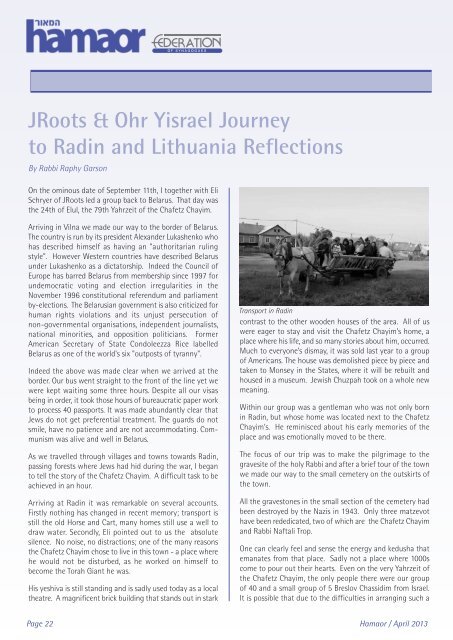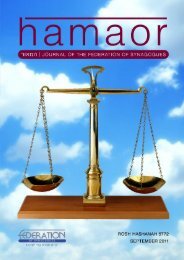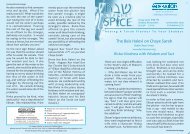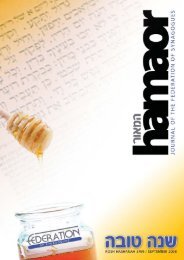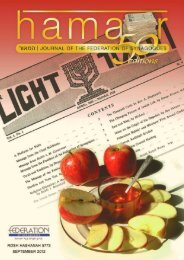Pesach 5773 - 18/03/2013 - Federation Of Synagogues
Pesach 5773 - 18/03/2013 - Federation Of Synagogues
Pesach 5773 - 18/03/2013 - Federation Of Synagogues
Create successful ePaper yourself
Turn your PDF publications into a flip-book with our unique Google optimized e-Paper software.
JRoots & Ohr Yisrael Journey<br />
to Radin and Lithuania Reflections<br />
By Rabbi Raphy Garson<br />
On the ominous date of September 11th, I together with Eli<br />
Schryer of JRoots led a group back to Belarus. That day was<br />
the 24th of Elul, the 79th Yahrzeit of the Chafetz Chayim.<br />
Arriving in Vilna we made our way to the border of Belarus.<br />
The country is run by its president Alexander Lukashenko who<br />
has described himself as having an "authoritarian ruling<br />
style". However Western countries have described Belarus<br />
under Lukashenko as a dictatorship. Indeed the Council of<br />
Europe has barred Belarus from membership since 1997 for<br />
undemocratic voting and election irregularities in the<br />
November 1996 constitutional referendum and parliament<br />
by-elections. The Belarusian government is also criticized for<br />
human rights violations and its unjust persecution of<br />
non-governmental organisations, independent journalists,<br />
national minorities, and opposition politicians. Former<br />
American Secretary of State Condoleezza Rice labelled<br />
Belarus as one of the world's six "outposts of tyranny".<br />
Indeed the above was made clear when we arrived at the<br />
border. Our bus went straight to the front of the line yet we<br />
were kept waiting some three hours. Despite all our visas<br />
being in order, it took those hours of bureaucratic paper work<br />
to process 40 passports. It was made abundantly clear that<br />
Jews do not get preferential treatment. The guards do not<br />
smile, have no patience and are not accommodating. Communism<br />
was alive and well in Belarus.<br />
As we travelled through villages and towns towards Radin,<br />
passing forests where Jews had hid during the war, I began<br />
to tell the story of the Chafetz Chayim. A difficult task to be<br />
achieved in an hour.<br />
Arriving at Radin it was remarkable on several accounts.<br />
Firstly nothing has changed in recent memory; transport is<br />
still the old Horse and Cart, many homes still use a well to<br />
draw water. Secondly, Eli pointed out to us the absolute<br />
silence. No noise, no distractions; one of the many reasons<br />
the Chafetz Chayim chose to live in this town - a place where<br />
he would not be disturbed, as he worked on himself to<br />
become the Torah Giant he was.<br />
His yeshiva is still standing and is sadly used today as a local<br />
theatre. A magnificent brick building that stands out in stark<br />
Transport in Radin<br />
contrast to the other wooden houses of the area. All of us<br />
were eager to stay and visit the Chafetz Chayim’s home, a<br />
place where his life, and so many stories about him, occurred.<br />
Much to everyone’s dismay, it was sold last year to a group<br />
of Americans. The house was demolished piece by piece and<br />
taken to Monsey in the States, where it will be rebuilt and<br />
housed in a museum. Jewish Chuzpah took on a whole new<br />
meaning.<br />
Within our group was a gentleman who was not only born<br />
in Radin, but whose home was located next to the Chafetz<br />
Chayim’s. He reminisced about his early memories of the<br />
place and was emotionally moved to be there.<br />
The focus of our trip was to make the pilgrimage to the<br />
gravesite of the holy Rabbi and after a brief tour of the town<br />
we made our way to the small cemetery on the outskirts of<br />
the town.<br />
All the gravestones in the small section of the cemetery had<br />
been destroyed by the Nazis in 1943. Only three matzevot<br />
have been rededicated, two of which are the Chafetz Chayim<br />
and Rabbi Naftali Trop.<br />
One can clearly feel and sense the energy and kedusha that<br />
emanates from that place. Sadly not a place where 1000s<br />
come to pour out their hearts. Even on the very Yahrzeit of<br />
the Chafetz Chayim, the only people there were our group<br />
of 40 and a small group of 5 Breslov Chassidim from Israel.<br />
It is possible that due to the difficulties in arranging such a<br />
Page 22 Hamaor / April <strong>2013</strong>


